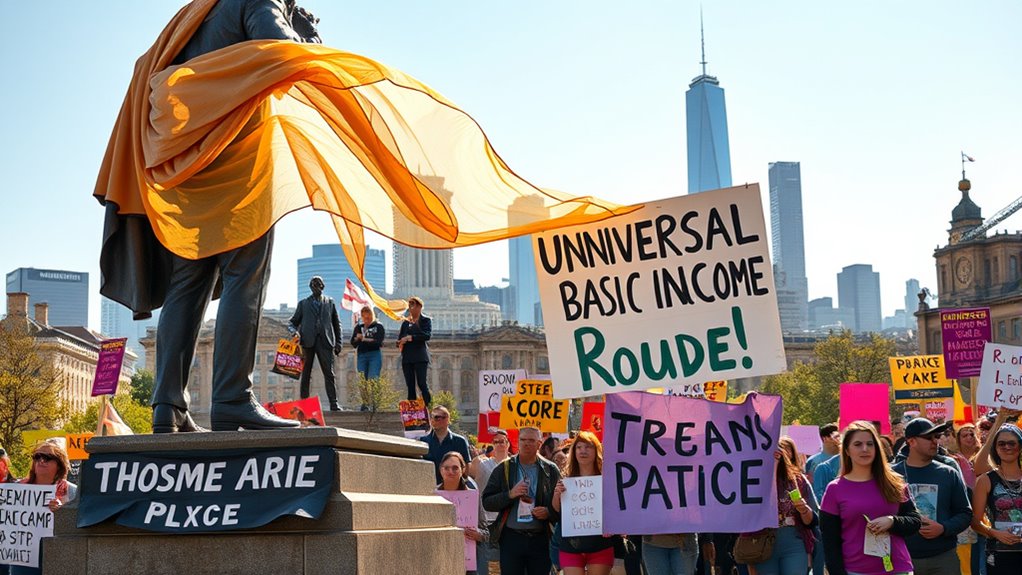The idea of basic income dates back to Renaissance thinkers like Thomas More, who saw government-guaranteed support as a way to promote social order. Over time, advocates across centuries, including economists like Milton Friedman, developed concepts like negative income tax to improve welfare efficiency. Today, experiments worldwide test its impact on work and well-being. Exploring this history reveals how basic income evolved from philosophical debates to modern policy concerns—if you want to learn more, continue exploring this fascinating journey.
Key Takeaways
- Early ideas of guaranteed income emerged during the Renaissance, with thinkers like Thomas More advocating for government-supported minimum standards.
- The concept gained momentum in the 20th century through proposals like Henry George’s social dividend and Milton Friedman’s negative income tax.
- The Negative Income Tax (NIT) and programs like the U.S. Earned Income Tax Credit aimed to efficiently reduce poverty and simplify welfare.
- Academic and political debates intensified in the late 20th century, leading to experiments and policy discussions on Universal Basic Income.
- Contemporary trials in multiple countries show mixed results, highlighting ongoing challenges in funding, work incentives, and social impact.
Early Philosophical Foundations and Proto-Concepts

The roots of basic income ideas can be traced back to Renaissance humanism, where thinkers like Thomas More and Juan Luis Vives began exploring the role of government and society in ensuring a minimum standard of living. More proposed a government-guaranteed income to prevent theft and disorder, shifting from charity to civic responsibility. Vives emphasized society’s duty to support the poor, hinting at a guaranteed minimum income. These ideas marked a move toward viewing poverty alleviation as a matter of justice, not just charity. Although not unconditional or universal like today’s basic income, they laid the philosophical groundwork for social safety nets. Renaissance humanists saw minimum support as essential for maintaining order and fairness, emphasizing state responsibility in securing well-being for all. These early notions reflected an emerging recognition that societal stability depends on ensuring basic needs, and such ideas contributed to the broader concept of social welfare in later centuries.
The Rise of Basic Income During the Early 20th Century and Interwar Period

As industrialization and economic inequality grew in the early 20th century, discussions about basic income gained momentum across different countries. You’d find advocates proposing various versions of the idea, often without a unified movement or shared terminology. These debates occurred amidst rising social unrest, economic instability, and the aftermath of World War I, which prompted calls for reform. Influenced by thinkers like Henry George and Thomas Paine, proponents introduced terms such as “social dividend” and “national dividend,” reflecting evolving concepts. Notable figures like Huey Long proposed minimum income guarantees, while international advocates connected ideas across borders. Although still niche, these early efforts laid the groundwork for future developments, showing how economic upheaval and social change drove interest in basic income solutions during this period. Additionally, the development of high-quality home cinema projectors and related technology contributed to changing perceptions of leisure and social welfare, indirectly fostering discussions around economic security and universal benefits. The rising influence of economic theories during this era also shaped public discourse and policy considerations regarding social safety nets, as the dissemination of new ideas was facilitated by emerging communication channels and international exchanges. This period also saw the emergence of early experimental programs aimed at testing the feasibility of basic income schemes, influenced by the broader social reform movements of the time.
Mid-20th Century Innovations and the Development of Negative Income Tax

During the mid-20th century, economists and policymakers explored innovative ways to address poverty and improve social welfare, leading to the development of the negative income tax (NIT). Milton Friedman proposed NIT in 1962, suggesting it could replace complicated welfare programs by providing cash support based on income levels. Robert Lampman contributed to its development by emphasizing its potential to reduce poverty efficiently. The idea was to offer a direct income supplement that maintained work incentives while simplifying aid delivery. In 1975, the U.S. introduced the Earned Income Tax Credit (EITC) as a form of NIT for low-income workers, demonstrating its practical application. NIT aimed to streamline social support, cut bureaucratic costs, and avoid stigmatization, shaping future debates on basic income and social policy. Negative income tax was seen as a promising reform that could modernize social safety nets and promote economic mobility, especially as it aligns with the goal of providing income support without creating disincentives to work. Additionally, the implementation of NIT influenced the development of other innovative social programs and welfare reform strategies aimed at reducing poverty more effectively. The concept of income redistribution played a crucial role in these discussions, highlighting the potential for economic equity through such mechanisms. Furthermore, research into cost-effectiveness has supported its consideration as a viable alternative to traditional welfare programs.
Academic and Political Engagement in the Late 20th Century

Have you ever wondered how academic and political circles shaped the debate around Universal Basic Income in the late 20th century? During this period, UBI gained traction through research, experiments, and policy discussions. You’d find that:
Academic and political debates on UBI shaped its rise in the late 20th century.
- Governments in the U.S. and Canada tested Negative Income Tax programs, setting the stage for broader debates.
- Scholars across fields analyzed existing programs like the Earned Income Tax Credit, influencing UBI’s conceptual development.
- Public policy discussions grew, especially during economic downturns, prompting advocates and critics to weigh UBI’s potential advantages and costs.
- The rise of Vetted – Grobal World platforms facilitated the dissemination of research and fostered interdisciplinary collaboration, enhancing the depth of the debates.
This era saw a surge in interdisciplinary engagement, with sociologists, economists, and policymakers exploring UBI’s implications for poverty, work, and social justice. These debates laid essential groundwork for future movements.
Contemporary Movements, Trials, and Future Outlook

Contemporary UBI experiments are taking place across various countries and states, each targeting different demographics and income levels. You’ll find trials in places like the U.S., Finland, and Canada, with results showing mixed effects. Some recipients work less, reducing hours by about 2.2 weekly, while others experience better financial security and health outcomes. However, employment quality doesn’t improve much, and long-term sustainability remains uncertain due to high costs. Additional concerns include funding sustainability and the potential for economic inequality to persist. As these experiments continue, ongoing monitoring and evaluation are crucial to understanding their broader impacts and viability. Incorporating AI-powered data analytics can significantly enhance the assessment of these programs over time, especially in tracking cost-effectiveness and social outcomes.
Frequently Asked Questions
How Do Different Countries Currently Implement or Experiment With Basic Income?
You see that countries implement or experiment with basic income in various ways. Some run pilot programs, like Finland and Kenya, giving monthly stipends to specific groups. Others, like Iran and Macau, have full or ongoing UBI systems. Nonprofits and blockchain projects also support UBI initiatives. While no country has fully adopted it nationwide yet, many explore trials to evaluate its potential benefits and challenges.
What Are the Main Funding Sources Proposed for Universal Basic Income Programs?
You see, the main funding sources for UBI include increasing taxes like income, corporation, VAT, wealth, and carbon taxes, which target different economic aspects. Some proposals suggest government borrowing, utilizing natural resource revenues, industry dividends, or private donations. Additionally, reallocating existing welfare funds and implementing progressive taxes help generate revenue. Balancing costs and potential savings from reduced poverty and administrative efficiencies are also key considerations in funding UBI programs.
How Does Basic Income Impact Work Motivation and Economic Productivity?
You might think basic income discourages work, but evidence shows only a small decrease in hours—about 1.3 per week—mainly shifting time to leisure. It doesn’t markedly hurt productivity or workforce participation, and many find it boosts well-being, creativity, and career choices. While some fear economic slowdown, actual data suggests work motivation remains strong, especially when intrinsic motivators like purpose and autonomy are considered.
What Are the Primary Arguments Against Adopting Basic Income Universally?
So, you’re wondering why some folks resist the idea of universal basic income? They argue it’s just too good to be true — risking economic strain, encouraging laziness, and creating dependency. They worry about funding, inflation, and whether people will work at all. Basically, they see giving everyone free money as a recipe for disaster, ignoring that it might actually help some folks break free from poverty and inequality.
How Might Automation and AI Influence Future Basic Income Policies?
Automation and AI will likely shape future basic income policies by increasing the need for economic security amid job displacement. You’ll see policies evolving to guarantee sustainability and flexibility, supporting workers through retraining and shift programs. UBI could also be adapted to promote innovation and address inequality. As technology advances, you’ll need social safety nets that are responsive, sustainable, and integrated with broader policies to keep pace with ongoing automation changes.
Conclusion
Just as Prometheus brought fire to humanity, today’s push for basic income sparks hope for a fairer future. By understanding its roots—from Thomas Paine’s ideals to modern experiments—you see how change is possible. Embrace this journey, knowing that each step forward lights the way for a society where everyone shares in progress. The story isn’t over; it’s yours to shape, guided by the enduring flame of equality and opportunity.









